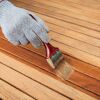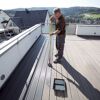Extensive information about the latest know-how about wood and natural wood pests. Protects wood against water and makes it durable. Profit from our expertise.

Sustainably and reliably protected with Remmers
The natural material wood
Premium protection based on nature’s example
Humans feel good near this material. Today, leading architects and designers prefer to use building materials that are as natural as possible when designing gardens and buildings, in particular for interior spaces. One reason for the growing popularity is the uniqueness and sense of well-being that wood conveys. Trees already have the best natural wood preservation possible - the bark. This protects the wood against drying out and especially against diverse weathering factors like the sun, wind, rain, frost and heat. All the important nutrients that the tree needs to grow and flourish are supplied via the roots.
From an early stage, Remmers’ products aimed to also provide this natural protection to installed wood in the shape of highly developed coating systems. Wood in its thousands of various structures and colours forms the basis for its use in the new classic range available from specialised retailers that comprises glazes, top coats and oils.
Remmers’ [eco] products that are integrated into its overall range reflect the company’s commitment to ecology and general sustainable responsibility for humans and the environment.
Natural wood pests

Outdoor wood is permanently exposed to moisture: Rain, dew, condensation etc. increases the moisture level, and evaporation decreases it. The consequence: Cracks in the surface. Moisture that penetrates the wood through these cracks or by means of diffusion needs to leave the wood again, otherwise waterlogging occurs below the surface, which is a breeding ground for blue stain and wood-damaging rot.
It is therefore important to select the right coating for the wood component:
- The so-called dimensional precision of the components is particularly important for windows and doors. Therefore, thick-layer stains are used here: The coating ensures that no moisture can penetrate the wood, thereby avoiding component deformation as a result of swelling and shrinkage, which ultimately could prevent it from being opened or closed.
- In the case of so-called non-dimensionally stable components, e.g. wood claddings and fences, it is not possible to completely rule out the possibility of moisture penetration e.g. via the end-grain woods or due to cracks. It is important to use breathable coatings (e.g. thin layer glazes) so that the wood can breathe and the moisture can leave the wood again.
The sun not only stresses wooden surfaces with heat, its UV radiation also penetrates the wood. In combination with precipitation, it can change the colour of the unprotected wood in a few weeks or months, i.e. the wood appears silver-grey. The wood surface then also has upright fine wood fibres and become weaker. The usually unwanted colour and surface changes can be prevented by using pigmented coatings. For the first time, permanent protection glaze UV in transparent UV+ allow the application of a transparent coating to wood used outdoors that, thanks to the highly effective UV blocker, delays the greying effect.
Algae
These lower organisms ensure green discolouration and an optical impairment of wood outdoors, in particular in wooded or forested areas. HK glaze is an algicide and prevents premature green discolouration.
Blue stain
Blue stain is a so-called wood staining fungi and is visible as black-blue discolouration. Blue stain does not destroy the wood, it only impairs its appearance. However blue stain paves the way for wood-damaging fungi (rot), because it perforates the cell walls and facilitates better water absorption in the wood (capillarity).
Rot
Rot is the most dangerous form of damaging fungi. It destroys the structure of the wood. The wood loses its stability: It becomes rotten.
Wood-damaging insects
In addition to the wood staining and destroying fungi, parasitic animal infestations also attack the wood. For instance,the house longhorn beetle is one of the most dangerous wood-damaging insects in moderate climates and is particularly prevalent in soft wood. It lays its eggs in existing cracks and the grubs like to eat the outer layers. The damage caused by other wood-damaging insects also follows a similar scheme: The insect lays the egg in or on the wood. The grub hatches from the egg - the grub is the actual destroyer of the wood.
Durability of wood types
Wood refinement? When is additional wood preservation needed?
Depending on the durability of the wood type that is used, a decision can be made about the necessity for a chemical wood preservative for wood outdoors. A finish with biocide-free products is usually enough for ‘very durable’ and ‘durable’ woods. ‘Moderate’ to ‘non-durable’ woods also require a chemical wood preservative, e.g. to protect against blue stain and rot. The wood types are only classified based on the heartwood. However, usually, conventional woods also contain some sap wood that is not generally classified as durable.
These kinds of woods should therefore not be used outdoors without a chemical wood preservative.
Constructive wood preservation
Do not offer moisture any areas to attack
Permanent moisture loads are the main cause of wood staining and wood-destroying fungi. To rule this out as far as possible, wood components outdoors should be designed to that water contact is avoided. If this is not possible, steps should be taken to ensure that the wood can dry again quickly. Standing water on wood constructions should also be avoided. Constructive wood preservation measures include e.g. adequately large roof overhangs, avoidance of direct contact with the ground (be aware of splashwater!), inclined surfaces, rounded edges and covering of horizontal areas. If a higher protection level is required, the wood can be impregnated with an officially approved wood preservative (e.g. wood preservative primer) before the decorative coating.
General processing information
-
Tool
-
Preparation
-
Processing



